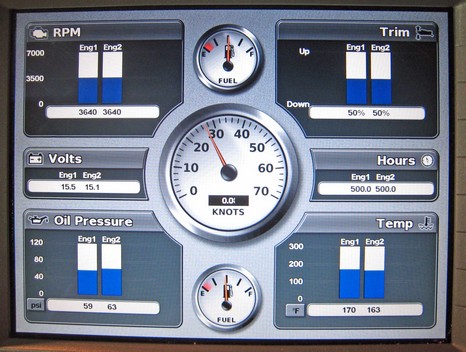Garmin NMEA 2000, good news!

I had a long phone interview with Garmin this morning and was mucho pleased to learn that the limited NMEA 2000 support in the 4 and 5000 series is only temporary. Garmin’s Marine Sales Manager Greg DeVries explained that the reason they took the approach they did—i.e. N2K engines only, as seen in the (simulated) screen above and its alternate—is that they’d “still be in development” if they hadn’t. He promised that “Going forward, we’re absolutely going to embrace full NMEA 2000. It will just be a software upgrade for existing customers.” That makes what I first heard sit a whole lot better!












That is a much better answer. Way to go Garmin!
I hate to rain on the parade, but an installer and savvy boat owner who recently tried to use the Offshore Systems N2K tank sensors have told me that they found it was very difficult to debug N2K sentences. They also found the wiring to be much more bulky than NMEA 0183.
The combination turned them off on N2K.
Any suggestions on tools for debugging sentences and ways to mitigate the bulk of the wiring T’s and terminators?
I feel a lot better about some recent recommendations to clients regarding Garmin equipment!!
CharlieJ
Russ, there are a number of PC tools for monitoring NMEA 2000 messages, Maretron has a troubleshooting tool, and current Simrad multifunction displays do a particularly good job of showing what’s happening on a N2K network. But why did they have to debug? I’ve put together a pretty loaded system, and it didn’t come close to filling the pipeline; so turning off some sentences to save bandwidth is not really an issue. Plus the messages are much more highly regulated, and there is a pretty serious certification process, so if a device is programmed to read a certain message, it should.
And, yes, the standard cable is fairly bulky, but it’s also nearly bomb proof and can replace umpteen 0183 data (and sensor power) cables, plus do things 0183 will never do (like single cable engine monitoring). Given a choice, I’d take that DeviceNet cabling in a heartbeat. Plus there are lighter weight sort-of alternatives like Lowrance’s, and more coming.
And, hey Charlie, I sort of know how you feel. For me it was a buddy, not a client. He really liked the idea of an ultrasonic weather station and some backup N2K sensors on his custom 50′ and I presumed that his pair of Garmins–a 4212 and a 5212 (which is turning out to be a very interesting combination)–would support them. Just hoping that Garmin comes through more or less before the boat is launched.
Ben,
Good news and bad news.
The good news is that when I search for NMEA 2000 software, the top Google response is…. Panbo!
The bad news is that you’re not in the software business, and not much else showed up.
So maybe you could drop some names, or add a link to somewhere, or generally shed more light on this software. Every network needs a way to peek inside and see what’s happening when it’s not happening as expected.